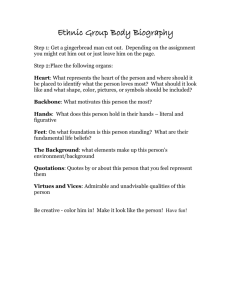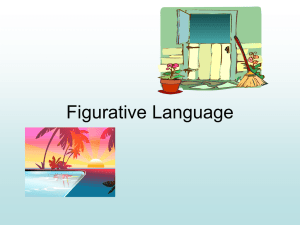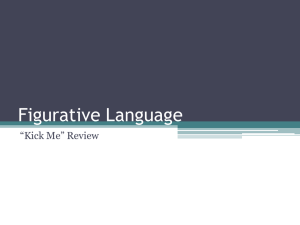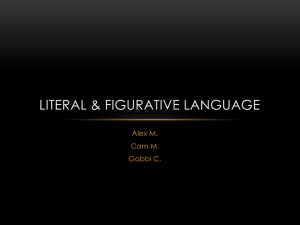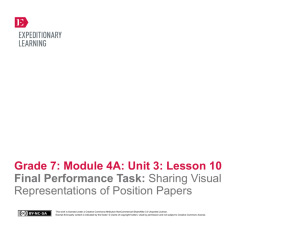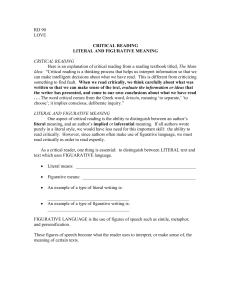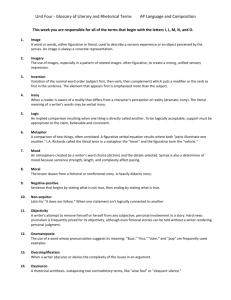Grade 6 Module 2B, Unit 2, Lesson 5
advertisement
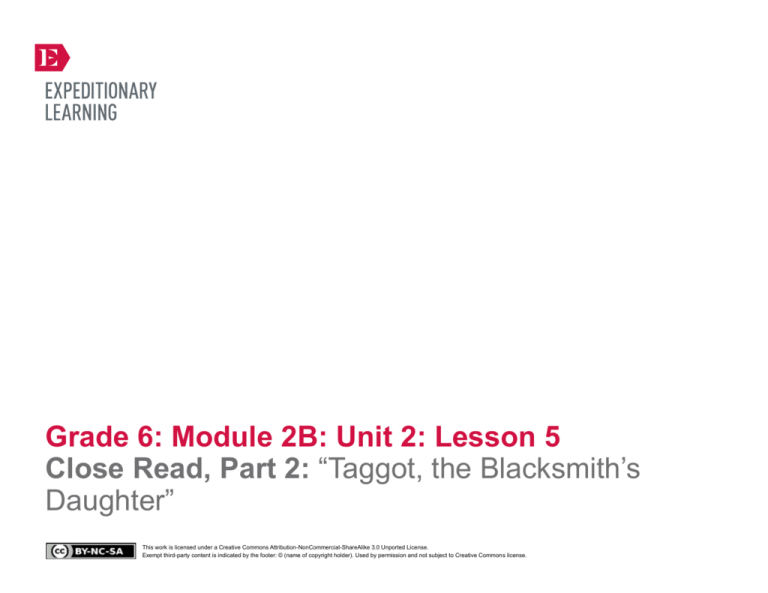
Grade 6: Module 2B: Unit 2: Lesson 5 Close Read, Part 2: “Taggot, the Blacksmith’s Daughter” This work is licensed under a Creative Commons Attribution-NonCommercial-ShareAlike 3.0 Unported License. Exempt third-party content is indicated by the footer: © (name of copyright holder). Used by permission and not subject to Creative Commons license. GRADE 6: MODULE 2B: UNIT 2: LESSON 5 Close Read, Part 2: “Taggot, the Blacksmith’s Daughter” Long-Term Targets Addressed (Based on NYSP12 ELA CCLS) I can determine the meaning of literal and figurative language (metaphors and similes) in literary text. (RL.6.4) I can analyze how an author’s word choice affects tone and meaning in a literary text. (RL.6.4) I can analyze how a particular sentence, stanza, scene, or chapter fits in and contributes to the development of a literary text. (RL.6.5) I can demonstrate understanding of figurative language, word relations, and nuances in word meanings. (L.6.5) I can interpret figures of speech in context. (L.6.5a) I can use the relationship between particular words to better understand each of the words. (L.6.5b) I can distinguish among the connotations (associations) of words with similar denotations (definitions). (L.6.5c) Supporting Learning Targets Ongoing Assessment • I can determine the meaning of figurative language in the monologue “Taggot, the Blacksmith’s Daughter.” • Themes of Adversity graphic organizer for “Mogg, the Villein’s Daughter” (from homework) • I can analyze how the author’s word choice affects the tone of the monologue “Taggot, the Blacksmith’s Daughter.” • Figurative Language graphic organizer for “Taggot, the Blacksmith’s Daughter” • I can analyze how a single stanza (or sentence) adds to the whole monologue. • Text-Dependent Questions: “Taggot, the Blacksmith’s Daughter” • Exit Ticket: Literal to Figurative, Simile and Metaphors Created by Expeditionary Learning, on behalf of Public Consulting Group, Inc. © Public Consulting Group, Inc., with a perpetual license granted to Expeditionary Learning Outward Bound, Inc. NYS Common Core ELA Curriculum • G6:M2B:U2:L5 • June 2014 • 1 GRADE 6: MODULE 2B: UNIT 2: LESSON 5 Close Read, Part 2: “Taggot, the Blacksmith’s Daughter” Agenda Teaching Notes 1. Opening • Students begin this lesson in their triads discussing the themes of adversity in “Mogg, the Villein’s Daughter,” which they read for homework. A. Themes of Adversity and Figurative Language: “Mogg, the Villein’s Daughter” (7 minutes) B. Unpacking Learning Targets (3 minutes) 2. Work Time A. Identifying Figurative Language: “Taggot, the Blacksmith’s Daughter” (15 minutes) B. Word Choice and Tone: “Taggot, the Blacksmith’s Daughter” (15 minutes) 3. Closing and Assessment A. Changing Figurative to Literal and Literal to Figurative (5 minutes) 4. Homework • In this lesson, students review figurative and literal language and practice identifying examples from song lyrics. • This lesson follows a similar pattern to previous lessons in which students worked with partners to analyze figurative language and identify the ways word choice can affect tone and meaning. • Students further their work on figurative and literal language by completing an exit ticket. • In advance: – Form student partnerships. – Write four quotes from “Taggot, the Blacksmith’s Daughter” on the Figurative Language anchor chart. – Add to the Academic Word Wall: connotation, denotation, and nuance. • Post: Learning targets. A. Read “Jack, the Half-Wit” and complete the Themes of Adversity graphic organizer. Created by Expeditionary Learning, on behalf of Public Consulting Group, Inc. © Public Consulting Group, Inc., with a perpetual license granted to Expeditionary Learning Outward Bound, Inc. NYS Common Core ELA Curriculum • G6:M2B:U2:L5 • June 2014 • 2 GRADE 6: MODULE 2B: UNIT 2: LESSON 5 Close Read, Part 2: “Taggot, the Blacksmith’s Daughter” Lesson Vocabulary Materials figurative language, figures of speech, literal language, metaphor, simile, personification, word choice, tone, connotation, denotation, nuance • Good Masters! Sweet Ladies! (book; one per student) • Document camera • Themes of Adversity anchor chart (begun in Lesson 2) • Academic Word Wall (begun in Lesson 2; see Lesson 2 supporting material for teacher reference) • Figurative and Literal Language reference sheet (from Lesson 3) • Figurative Language graphic organizer for “Taggot, the Blacksmith’s Daughter” (one per student and one to display) • Text-Dependent Questions: “Taggot, the Blacksmith’s Daughter” (one per student and one to display) • Close Reading Guide: “Taggot, the Blacksmith’s Daughter” (for teacher reference) • Exit Ticket: Literal to Figurative, Simile and Metaphors (one per student) • Themes of Adversity graphic organizer for “Jack, the Half-Wit” (one per student) Created by Expeditionary Learning, on behalf of Public Consulting Group, Inc. © Public Consulting Group, Inc., with a perpetual license granted to Expeditionary Learning Outward Bound, Inc. NYS Common Core ELA Curriculum • G6:M2B:U2:L5 • June 2014 • 3 GRADE 6: MODULE 2B: UNIT 2: LESSON 5 Close Read, Part 2: “Taggot, the Blacksmith’s Daughter” Opening Meeting Students’ Needs A. Themes of Adversity and Figurative Language: “Mogg, the Villein’s Daughter” (7 minutes) • Ask students to gather their book Good Masters! Sweet Ladies! and their Themes of Adversity graphic organizer for “Mogg, The Villein’s Daughter” and sit with in their triads. • Many students will benefit from seeing the Themes of Adversity graphic organizer displayed to help them focus on the task. • Using a document camera, display the Themes of Adversity graphic organizer for “Mogg, The Villein’s Daughter.” • Ask triads to discuss one theme of adversity Mogg faced, the text-based evidence supporting the adversity (including page number), and the group of people affected by the adversity. • Circulate and provide support. Ask probing questions, if needed: • Reviewing homework holds all students accountable for reading the monologue and completing their homework. * “What challenge or problem do Mogg and her family face?” * “What does it mean when the author says, ‘He can’t lift his hand’? What challenge or adversity does this statement suggest?” • Remind students to record new thinking on their graphic organizer. • Refocus whole group. Ask for volunteers to share out. • Listen for student comments that are versions of the following: • One of the challenges Mogg is confronted with is abuse. Mogg’s father abused her brother, Jack, and her mother. On page 25 Mogg says, “He beat Jack, and the lad is a half-wit.” She adds, “Mother can only see from one eye.” • Another theme of adversity Mogg and her family faced was alcoholism. Mogg’s father drank. On page 25 Mogg says, “He wasn’t a good man, always ale-drunk.” • A third adversity Mogg’s family was confronted with was the death of her father, their provider. Mogg’s brother, Jack, faced personal challenges. As a result, Mogg and her mother were left to provide for the family. • Add these themes to the Themes of Adversity anchor chart. • Cold call triads to share the group of people affected by these challenges or adversities of Mogg and her family. • Listen for: “Mogg’s entire family as well as other serfs in a similar position.” • Cold call triads to share their responses from the third column of the organizer: “Do these adversities exist today?” • Listen for: “Some families are confronted with poverty, alcoholism, death of a parent, and/or abuse.” Created by Expeditionary Learning, on behalf of Public Consulting Group, Inc. © Public Consulting Group, Inc., with a perpetual license granted to Expeditionary Learning Outward Bound, Inc. NYS Common Core ELA Curriculum • G6:M2B:U2:L5 • June 2014 • 4 GRADE 6: MODULE 2B: UNIT 2: LESSON 5 Close Read, Part 2: “Taggot, the Blacksmith’s Daughter” Meeting Students’ Needs Opening (continued) B. Unpacking Learning Targets (3 minutes) • Invite students to read the learning targets with you: * “I can determine the meaning of figurative language in the monologue ‘Taggot, the Blacksmith’s Daughter.’” * “I can analyze how the author’s word choice affects the tone of the monologue ‘Taggot, the Blacksmith’s Daughter.’” * “I can analyze how a single stanza (or sentence) adds to the whole monologue.” • Remind students that figurative language, literal language, word choice, tone, and stanza were discussed in Lesson 3. Underline these words in the targets and point out their definitions on the Academic Word Wall. • Share that precise words were chosen to convey or reveal the attitude and feelings of the main character. The word choice created tone. For example, the author chose to name Mogg’s cow Paradise. The word paradise has a connotation, or an association, of being positive and harmonious. The tone conveyed is one of happiness. Paradise provided a life of happiness for Mogg and her family: milk for the market, a calf for the spring, dung to patch the roof, and a warm body to sleep next to in the winter. • Also share that when the author uses the literal meanings of words to communicate meaning, it is a denotation. For example, Schlitz writes, “Mother kissed his hand, and we watched him ride off, and waited till dark, to take back Paradise.” This reference is considered literal because Mogg’s family would take their cow back. • Tell students that authors also use nuance in writing, which is a subtle difference in word choice. For example, an author might write, “Her giggle was childlike” or “Her laughter was childish.” Each communicates a different meaning because of the words childlike and childish. • Explain that all of these word choices were made by the author after careful consideration. Created by Expeditionary Learning, on behalf of Public Consulting Group, Inc. © Public Consulting Group, Inc., with a perpetual license granted to Expeditionary Learning Outward Bound, Inc. NYS Common Core ELA Curriculum • G6:M2B:U2:L5 • June 2014 • 5 GRADE 6: MODULE 2B: UNIT 2: LESSON 5 Close Read, Part 2: “Taggot, the Blacksmith’s Daughter” Work Time Meeting Students’ Needs A. Identifying Figurative Language: “Taggot, the Blacksmith’s Daughter” (15 minutes) • Ask students to take out their Figurative and Literal Language reference sheets and display a copy using the document camera. • Consider partnering ELLs who speak the same home language when discussion of complex content is required. This can allow them to have more meaningful discussions and clarify points in their native language. • Form student partnerships. • Tell students they are now going to look closely at four examples of figurative language from “Taggot, the Blacksmith’s Daughter.” • Distribute the Figurative Language graphic organizer for “Taggot, the Blacksmith’s Daughter” and display a copy using the document camera. Remind students that this figurative language activity was introduced in Lesson 3. • Explain that the first column contains examples of figurative language from the monologue. Ask students to use their Figurative and Literal Language reference sheets to identify the type of figure of speech. Tell students that in Column 2 they define the literal meaning of the figurative language, and in Column 3 they should explain how the word choice adds to the understanding of the scene or character. • Circulate and support students as they determine the literal meanings of each example. Make note of those who need additional support. • Cold call partners to share their literal meanings and how they add to the understanding of the scene or character. • Listen for comments such as the following: – “‘The morn was clear as glass, and I was happy as a singing bird’ is a simile, – ‘His eyes were as dark as rivers’ is a simile, and – ‘The glory was his face’ is a metaphor. ‘ – I never did speak. I thought if I opened my mouth he’d know my whole heart’ is an example of imagery.” • After discussion of Columns 2 and 3, share with students that they will continue analyzing Laura Amy Schlitz’s word choice in a close read of “Taggot, the Blacksmith’s Daughter.” Created by Expeditionary Learning, on behalf of Public Consulting Group, Inc. © Public Consulting Group, Inc., with a perpetual license granted to Expeditionary Learning Outward Bound, Inc. NYS Common Core ELA Curriculum • G6:M2B:U2:L5 • June 2014 • 6 GRADE 6: MODULE 2B: UNIT 2: LESSON 5 Close Read, Part 2: “Taggot, the Blacksmith’s Daughter” Work Time (continued) Meeting Students’ Needs B. Word Choice and Tone: “Taggot, the Blacksmith’s Daughter” (15 minutes) • Invite students to sit in triads. • When reviewing graphic organizers or recording forms, consider using a document camera to display them for students who struggle with auditory processing. • Remind them that in Lesson 4, they did four readings of Taggot. Today, they will continue to look closely at the monologue, but this time they will shift their attention to word choice. • Distribute the Text-Dependent Questions: “Taggot, the Blacksmith’s Daughter.” • Using a document camera, display a copy of the Text-Dependent Questions: “Taggot, the Blacksmith’s Daughter” to model recording responses as you guide the class through the document. • Providing models of expected work supports all learners, especially those who are challenged. • Refer to the Close Reading Guide: “Taggot, the Blacksmith’s Daughter” (for teacher reference) to guide the discussion. Closing and Assessment Meeting Students’ Needs A. Changing Figurative to Literal and Literal to Figurative (5 minutes) • Distribute the Exit Ticket: Figurative and Literal Language. • Invite students to read the examples of the similes and metaphors with you. • Ask them to Think-Pair-Share: * “What is the literal language for each simile and metaphor?” • Call on volunteers to share. • Ask students to create their own simile and metaphor using the literal example. • Distribute Themes of Adversity graphic organizer for “Jack, the Half-Wit” for homework. Homework Meeting Students’ Needs • Read “Jack, the Half-Wit” and complete the Themes of Adversity graphic organizer. Created by Expeditionary Learning, on behalf of Public Consulting Group, Inc. © Public Consulting Group, Inc., with a perpetual license granted to Expeditionary Learning Outward Bound, Inc. NYS Common Core ELA Curriculum • G6:M2B:U2:L5 • June 2014 • 7 Grade 6: Module 2B: Unit 2: Lesson 5 Supporting Materials This work is licensed under a Creative Commons Attribution-NonCommercial-ShareAlike 3.0 Unported License. Exempt third-party content is indicated by the footer: © (name of copyright holder). Used by permission and not subject to Creative Commons license. GRADE 6: MODULE 2B: UNIT 2: LESSON 5 Figurative Language Graphic Organizer for Taggot, the Blacksmith’s Daughter Name: Date: Example of figurative language/ what kind of figurative language is it? What it means literally How it adds to my understanding of the scene or character “The morn was clear as glass, and I was happy as a singing bird.” (6) “His eyes were dark as rivers.” (7) “The glory was his face—” (7) “I never did speak. I thought if I opened my mouth he’d know my whole heart.” Created by Expeditionary Learning, on behalf of Public Consulting Group, Inc. © Public Consulting Group, Inc., with a perpetual license granted to Expeditionary Learning Outward Bound, Inc. NYS Common Core ELA Curriculum • G6:M2B:U2:L5 • June 2014 • 9 GRADE 6: MODULE 2B: UNIT 2: LESSON 5 Text-Dependent Questions: “Taggot, the Blacksmith’s Daughter” Name: Date: Questions Response with Evidence “There’s something else. I’ve stared into the Round Pool and it’s hard to tell—the water’s never still but I think I’m ugly. Big and ugly and shy in the bargain. Mother says I’ll likely not marry at all.” 1. What is the meaning of “in the bargain”? Created by Expeditionary Learning, on behalf of Public Consulting Group, Inc. © Public Consulting Group, Inc., with a perpetual license granted to Expeditionary Learning Outward Bound, Inc. NYS Common Core ELA Curriculum • G6:M2B:U2:L5 • June 2014 • 10 GRADE 6: MODULE 2B: UNIT 2: LESSON 5 Text-Dependent Questions: “Taggot, the Blacksmith’s Daughter” Questions Response with Evidence “There’s no one better to quiet a horse. I lay my big hands on them, and feel them trembling—I know how they feel. They’re like me: big and timid. So I breathe sweet peace to them—not with my lips, but through my fingers—and they hear me, not with their ears but through their skins.” 3. The author writes the phrase “I breathe sweet peace to them—not with my lips, but through my fingers—and they hear me.” What does she mean? He had brown hair. Not golden like the knights in story, and his eyes were dark as rivers. The glory was his face—the shape of it—I don’t have words.” 4. Why did the author choose “glory” in the phrase “The glory was his face—”? Created by Expeditionary Learning, on behalf of Public Consulting Group, Inc. © Public Consulting Group, Inc., with a perpetual license granted to Expeditionary Learning Outward Bound, Inc. NYS Common Core ELA Curriculum • G6:M2B:U2:L5 • June 2014 • 11 GRADE 6: MODULE 2B: UNIT 2: LESSON 5 Text-Dependent Questions: “Taggot, the Blacksmith’s Daughter” Questions Response with Evidence “… and he held out a coin—a farthing. I was sudden bold—I reached out my hand and shoved it away—and then (touching him was what did it) my face got hot.” 5. What does the phrase “sudden bold” mean? “He was gone by then, long gone, and it seems a long life—I may live fifty years, and not see him again.” 6. Why were the words “gone” and “long” repeated in this stanza? Created by Expeditionary Learning, on behalf of Public Consulting Group, Inc. © Public Consulting Group, Inc., with a perpetual license granted to Expeditionary Learning Outward Bound, Inc. NYS Common Core ELA Curriculum • G6:M2B:U2:L5 • June 2014 • 12 GRADE 6: MODULE 2B: UNIT 2: LESSON 5 Text-Dependent Questions: “Taggot, the Blacksmith’s Daughter” Questions Response with Evidence “Thinking that, I bent my head, and saw, lying on the anvil, a miracle: that sprig of hawthorn—from his cloak, on the anvil. If ’twere on the ground, it might only have fallen—but it was on the anvil.” 7. What does the repetition of the words “on the anvil” suggest? 8. How does this stanza contribute to the development of the theme of Taggot’s view of herself? Created by Expeditionary Learning, on behalf of Public Consulting Group, Inc. © Public Consulting Group, Inc., with a perpetual license granted to Expeditionary Learning Outward Bound, Inc. NYS Common Core ELA Curriculum • G6:M2B:U2:L5 • June 2014 • 13 GRADE 6: MODULE 2B: UNIT 2: LESSON 5 Close Reading Guide: “Taggot, the Blacksmith’s Daughter” (For Teacher Reference) Total Time: 15 minutes Questions Response with Evidence “There’s something else. I’ve stared into the Round Pool and it’s hard to tell—the water’s never still but I think I’m ugly. Big and ugly and shy in the bargain. Mother says I’ll likely not marry at all.” • Invite students to read the excerpt with you. 1. What is the meaning of “in the bargain”? • Ask them to discuss Question1 in triads. • Invite them to record their thoughts in the Notes column of their text-dependent question sheet. • Select volunteers to share their answers with the class. Listen for: Taggot means that not only is she ugly, but she is big, ugly and shy. “In the bargain” is an idiom meaning “in addition.” Taggot feels she is ugly and, in addition, big and shy. • Direct students’ attention to “Big and ugly and shy in the bargain.” • Ask: * “What do these words tell us about how Taggot feels?” Listen for: “Taggot feels hopeless. She feels she has no chance of finding love because of feeling big and ugly and shy.” Created by Expeditionary Learning, on behalf of Public Consulting Group, Inc. © Public Consulting Group, Inc., with a perpetual license granted to Expeditionary Learning Outward Bound, Inc. NYS Common Core ELA Curriculum • G6:M2B:U2:L5 • June 2014 • 14 GRADE 6: MODULE 2B: UNIT 2: LESSON 5 Close Reading Guide: “Taggot, the Blacksmith’s Daughter” (For Teacher Reference) Questions Response with Evidence “There’s no one better to quiet a horse. I lay my big hands on them, and feel them trembling—I know how they feel. They’re like me: big and timid. So I breathe sweet peace to them—not with my lips, but through my fingers—and they hear me, not with their ears but through their skins.” • Ask students to listen and follow the text as you reread the excerpt describing how Taggot works with horses. 3. The author writes the phrase “I breathe sweet peace to them—not with my lips, but through my fingers—and they hear me.” What does she mean? • Invite triads to read Question 3 and take notes in the right column of their Text-Dependent Questions. • Select volunteers from each triad to share their answers with the class. Listen for students to explain that Taggot’s gentle touch and calm manner calmed the horse’s spirit. • Ask students why the author chose the words “breathe sweet peace to them.” Listen for: “because breathing is a steady rhythm, and a constant rhythm can be calming.” • Ask: * “What does this phrase tell us about Taggot?” Listen for: “The phrase tells us that Taggot has a way to communicate with the horse through her sense of touch. It shows us she builds a trust and a relationship when she works with them.” Created by Expeditionary Learning, on behalf of Public Consulting Group, Inc. © Public Consulting Group, Inc., with a perpetual license granted to Expeditionary Learning Outward Bound, Inc. NYS Common Core ELA Curriculum • G6:M2B:U2:L5 • June 2014 • 15 GRADE 6: MODULE 2B: UNIT 2: LESSON 5 Close Reading Guide: “Taggot, the Blacksmith’s Daughter” (For Teacher Reference) Questions Response with Evidence He had brown hair. Not golden like the knights in story, and his eyes were dark as rivers. The glory was his face—the shape of it—I don’t have words.” • Ask triads to reread the excerpt in the left column. 4. Why did the author choose “glory” in the phrase “The glory was his face—”? • Invite volunteers to read their responses. • Invite them to discuss and take notes about why the author chose to use glory in Taggot’s description of Hugo. Listen for: “The author wanted the reader to understand that Taggot found pleasure in his face. She found him very handsome.” • Ask: * “How does the word glory contribute to our understanding of Taggot’s feelings for Hugo?” Listen for: There is joy in Taggot’s heart. She has a strong attraction for him. Created by Expeditionary Learning, on behalf of Public Consulting Group, Inc. © Public Consulting Group, Inc., with a perpetual license granted to Expeditionary Learning Outward Bound, Inc. NYS Common Core ELA Curriculum • G6:M2B:U2:L5 • June 2014 • 16 GRADE 6: MODULE 2B: UNIT 2: LESSON 5 Close Reading Guide: “Taggot, the Blacksmith’s Daughter” (For Teacher Reference) Questions Response with Evidence “… and he held out a coin—a farthing. I was sudden bold—I reached out my hand and shoved it away—and then (touching him was what did it) my face got hot.” • Invite students to read the excerpt with you. 5. What does the phrase “sudden bold” mean? • Select volunteers to share aloud their answers with the class. • Ask triads to discuss Question 5 and then record their responses in the right column of their Text-Dependent Questions. Listen for: “It was a quick action and out of character for Taggot.” • Ask: * “What was Taggot feeling, and what words support your thinking?” Listen for: “Taggot felt embarrassed because her face got hot. She also did not want to be paid; she wanted to do this for him and shoved the money away.” “He was gone by then, long gone, and it seems a long life—I may live fifty years, and not see him again.” 6. Why were the words “gone” and “long” repeated in this stanza? • Ask students to reread the passage with you. • Invite them to take notes in the right column. • Select volunteers to share their responses. Listen for: “The author wants the reader to understand that Taggot probably will never have another chance to talk to Hugo. • Ask: * “How do you think Taggot was feeling?” Listen for: “Taggot is very sad for her missed opportunity.” Created by Expeditionary Learning, on behalf of Public Consulting Group, Inc. © Public Consulting Group, Inc., with a perpetual license granted to Expeditionary Learning Outward Bound, Inc. NYS Common Core ELA Curriculum • G6:M2B:U2:L5 • June 2014 • 17 GRADE 6: MODULE 2B: UNIT 2: LESSON 5 Close Reading Guide: “Taggot, the Blacksmith’s Daughter” (For Teacher Reference) Questions Response with Evidence “Thinking that, I bent my head, and saw, lying on the anvil, a miracle: that sprig of hawthorn—from his cloak, on the anvil. If ’twere on the ground, it might only have fallen—but it was on the anvil.” • Ask students to read the excerpt with you. 7. What does the repetition of the words “on the anvil” suggest? 8. How does this stanza contribute to the development of the theme of Taggot’s view of herself? • Invite them to discuss Question 7 in their triads and then record their responses. • Select volunteers from each triad to share their discussion and their answers with the class. Listen for: “The repetition of the words ‘on the anvil’ suggests that the hawthorn sprig was placed purposefully for Taggot. It showed it had not fallen on the ground.” • Read Question 8 with the students. • Invite them to record their responses in their TextDependent Questions. Ask students to share their responses. Listen for them to explain that Taggot’s view of herself as ugly may not be how Hugo or other people see her. Created by Expeditionary Learning, on behalf of Public Consulting Group, Inc. © Public Consulting Group, Inc., with a perpetual license granted to Expeditionary Learning Outward Bound, Inc. NYS Common Core ELA Curriculum • G6:M2B:U2:L5 • June 2014 • 18 GRADE 6: MODULE 2B: UNIT 2: LESSON 5 Exit Ticket: Figurative and Literal Language (Similes and Metaphors) Name: Date: Similes (use “like” or “as”) Metaphors (use “are” or “is”) Your eyes are like sunshine. You are sunshine. The noise is like music to my ears. The noise is music to my ears. You are as happy as a clown. You are a clown. Change the literal language in the sentence below into figurative language. Write a sentence describing the puppy meeting his owner that contains a simile. Then write a sentence describing the puppy meeting his owner that contains a metaphor. Literal language: “The little puppy ran to meet his owner.” Simile: Metaphor: Created by Expeditionary Learning, on behalf of Public Consulting Group, Inc. © Public Consulting Group, Inc., with a perpetual license granted to Expeditionary Learning Outward Bound, Inc. NYS Common Core ELA Curriculum • G6:M2B:U2:L5 • June 2014 • 19 GRADE 6: MODULE 2B: UNIT 2: LESSON 5 Theme of Adversity Graphic Organizer for “Jack, the Half-Wit” Name: Date: Guiding question: How do individuals survive in challenging environments? Directions: Read the monologue in Good Masters! Sweet Ladies! Determine the theme/themes of adversity and the group or groups of people affected. Record the text-based evidence. Include the page number where the evidence was found. Theme of adversity faced in this monologue and group of people affected Text-based evidence (include the page number where the evidence was found in the text) Created by Expeditionary Learning, on behalf of Public Consulting Group, Inc. © Public Consulting Group, Inc., with a perpetual license granted to Expeditionary Learning Outward Bound, Inc. Does this theme of adversity exist today? Explain. NYS Common Core ELA Curriculum • G6:M2B:U2:L5 • June 2014 • 20

